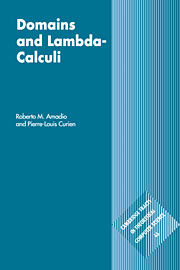Book contents
- Frontmatter
- Contents
- Preface
- Notation
- 1 Continuity and computability
- 2 Syntactic theory of the λ-calculus
- 3 D∞ models and intersection types
- 4 Interpretation of λ-calculi in CCC's
- 5 CCC's of algebraic dcpo's
- 6 The Language PCF
- 7 Domain equations
- 8 Values and computations
- 9 Powerdomains
- 10 Stone duality
- 11 Dependent and second order types
- 12 Stability
- 13 Towards linear logic
- 14 Sequentially
- 15 Domains and realizability
- 16 Functions and processes
- Appendix 1 Summary of recursion theory
- Appendix 2 Summary of category theory
- References and bibliography
- Index
1 - Continuity and computability
Published online by Cambridge University Press: 05 November 2011
- Frontmatter
- Contents
- Preface
- Notation
- 1 Continuity and computability
- 2 Syntactic theory of the λ-calculus
- 3 D∞ models and intersection types
- 4 Interpretation of λ-calculi in CCC's
- 5 CCC's of algebraic dcpo's
- 6 The Language PCF
- 7 Domain equations
- 8 Values and computations
- 9 Powerdomains
- 10 Stone duality
- 11 Dependent and second order types
- 12 Stability
- 13 Towards linear logic
- 14 Sequentially
- 15 Domains and realizability
- 16 Functions and processes
- Appendix 1 Summary of recursion theory
- Appendix 2 Summary of category theory
- References and bibliography
- Index
Summary
As the computation of a program proceeds, some (partial) information is read from the input, and portions of the output are gradually produced. This is true of mathematical reasoning too. Consider the following abstraction of a typical highschool problem for simple equation solving. The student is presented with three numerical figures – the data of the problem (which might themselves be obtained as the results of previous problems). Call them u, v, and w. The problem has two parts. In part 1, the student is required to compute a quantity x, and in the second part, using part 1 as a stepping stone, he (or she) is required to compute a quantity y. After some reasoning, the student will have found that, say, x = 3u + 4, and that y = x – v. Abstracting away from the actual values of u, v, w, x, and y, we can describe the problem in terms of information processing. We consider that the problem consists in computing x and y as a function of u, v, w, i.e., (x, y) = f(u, v, w). A first remark is that w is not used. In particular, if computing w was itself the result of a long, or even diverging, computation, the student would still be able to solve his problem. A second remark is that x depends on u only. Hence, again, if finding v is very painful, the student may still achieve at least part 1 of his problem.
- Type
- Chapter
- Information
- Domains and Lambda-Calculi , pp. 1 - 21Publisher: Cambridge University PressPrint publication year: 1998

